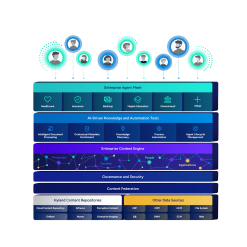6 questions to ask when evaluating low-code platforms
Organizations that have implemented a low-code development platform report higher revenue growth than their counterparts.

Harness the power of a unified content, process and application intelligence platform to unlock the value of enterprise content.
Learn more
Automate your document-centric processes with AI-powered document capture, separation, classification, extraction and enrichment.
Learn about Hyland IDPIt's your unique digital evolution … but you don't have to face it alone. We understand the landscape of your industry and the unique needs of the people you serve.
 Overview of industries
Overview of industries
Countless teams and departments have transformed the way they work in accounting, HR, legal and more with Hyland solutions.
 Overview of departments
Overview of departments
We are committed to helping you maximize your technology investment so you can best serve your customers.
 Overview of services
Overview of services

Discover why Hyland is trusted by thousands of organizations worldwide.
Hear from our customers
Our exclusive partner programs combine our strengths with yours to create better experiences through content services.
Overview of partners
Join The Shift newsletter for the latest strategies and expert tips from industry leaders. Discover actionable steps to stay innovative.
Register now
Hyland connects your content and systems so you can forge stronger connections with the people who matter most.
Learn about HylandWith our modern, open and cloud-native platforms, you can build strong connections and keep evolving.
 Dig deeper
Dig deeper
Solutions that provide not only timely service — but also positive, differentiating user experiences for employees, partners and those we serve — are critical to meeting the pace of business.
Modernization is a top strategic business priority, and research indicates organizations are most satisfied with the effectiveness of their business applications when they have implemented a low-code development platform. Even more revealing, such organizations report higher revenue growth than their counterparts.
Low-code development platforms use powerful development building blocks and visual design tools like drop-down menus, checkboxes and radio buttons. This enables the rapid creation, launch, use and change of powerful business applications. This is significant. It means:
This also means your organization can reduce risk while replacing legacy, proprietary or unsupported applications with modern solutions that meet immediate and future technology needs.
But not all low-code platforms are alike. Options in today’s marketplace include platforms containing general development tools, platforms built for content management, process automation, integration and extended enterprise search and proprietary tools that are built to specialize functionality within specific business systems.
To understand where your organization can realize benefits, and which type of low-code capabilities will offer the most value, start with answering these six questions:
1. What capabilities exist today with your current platforms or are available by upgrading to the latest versions?
In the content services platform space, transformational low-code capabilities are emerging at a rapid pace, built to meet today’s security, mobility and user-experience needs.
Bonus question: What low-code capabilities are available with the technology you already have in place that you aren’t using?
2. What do your line-of-business users have to say about their needs and wants?
Line-of-business stakeholders should be key participants in the low-code platform decision-making process. They are closest to specific business process needs and have intimate knowledge of what users expect and what roadblocks or challenges currently exist. They also have a pulse on evolving regulatory and market-driven requirements.
3. What business processes can you fix with a low-code platform instead of a multitude of limited purpose/functionality applications?
In today’s evolving digital landscape, it is no longer viable to have IT teams take on the heavy lifting of not only maintaining secure environments of hundreds of systems, but also delivering the solutions your employees need at the pace required in today’s digital-first, mobile-first and highly remote marketplace.
Instead, look for opportunities to address business challenges with a low-code development platform that offers other extensible capabilities, such as reporting and analytics, customer communications management, collaboration and automated content retention capabilities.
4. Does the low-code platform integrate with your core systems?
Key to evolving business processes, along with evolving requirements and event- or market-driven disruption, is having seamless integrations with critical systems whose data and content you use across the enterprise.
Low-code platforms should offer integration capabilities that do not rely on custom code. Look for platforms that have integration accelerators and proven integration capabilities that promote secure automation and collaboration — with high performance for reduced transaction times, and a complete view of information for employees, customers, partners and leadership.
5. How will you measure success after deployment?
It’s important to benchmark the current environment, including performance, challenges and user experience. This is key to have a clear understanding of how low-code-enabled process improvements have added value to the business, as well as to help identify other areas where low-code applications can deliver quick wins.
6. Will this low-code platform work with your cloud strategy?
Today’s IT departments are being asked to do more with less — more security, more availability, more disaster recovery, all with less budgetary allotment. The cloud is ideally suited to assist in these initiatives.
Modernization enables organizations to turn critical enterprise content into business insights. Hyland's highly configurable, low-code/no-code solutions deliver solutions at a pace that aligns with the shifting demands and needs of users, immediately and into the future.
